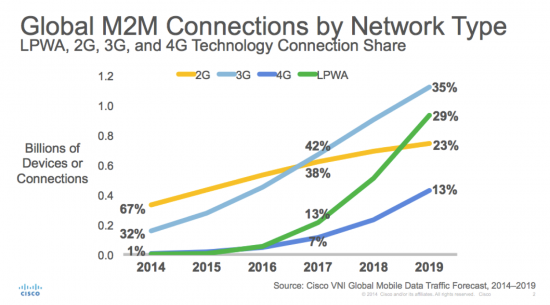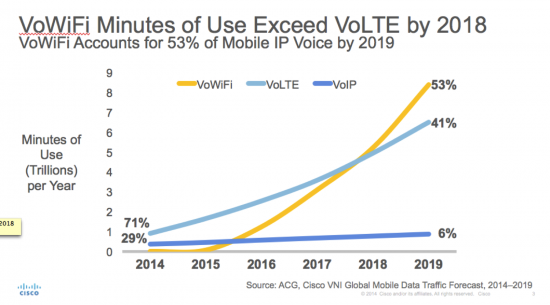Updated 2015 VNI Mobile Forecast Reveals Potential “Wildcards” for Mobile Devices, Networks and Services
This week, Cisco released its annual Visual Networking Index (VNI) Global Mobile Data Forecast, 2014 – 2019. Among the traditional top-line growth projections that indicate a healthy mobile industry (e.g., more than 5.2 billion global mobile users by 2019 and 10-fold mobile traffic growth over the next five years), there were several interesting trends that could have significant implications for mobile networking in the near future.
Mobile Devices: Laptops make a comeback and phablets start to emerge
While there is an overall growth in the number of mobile devices and connections, there is also a visible shift in the device mix. This year forecast shows a slight slowdown in the growth of tablets as a new device sub-category, phablets (included in our smartphone category), were began to show global adoption. Tablet growth was also affected by the introduction of lightweight laptops, which are quite similar to tablets in form factor but have more enhanced capabilities. Today, tablets are primarily being used as content consumption devices – ideally suited for video viewing in particular. Laptops are still serving as the dominant content creation device, particularly for business users (e.g., presentation, spreadsheet, and document development). While the absolute numbers or volume for smartphones (4.6 billion by 2019), tablets (nearly 300 million by 2019) and laptops (nearly 250 million by 2019) are growing, they are all losing their percentage share of total mobile devices and connections to the fastest growing mobile connection type – M2M (3.2 billion by 2019).

Mobile Networks: Low Power, Wide-Area (LPWA) networks may be optimal for campus-wide IoE applications
This year’s forecast includes M2M nodes connected via Low-Power, Wide-Area (LPWA) networks. These networks are opening new M2M use cases by delivering an optimized ultra-narrowband solution that can support a wide area of coverage with minimal power consumption and connectivity costs. LPWA solutions are opening a host of new Internet of Everything (IoE) use cases for mobile network operators (MNOs) that could not have been addressed by cellular networks alone (early adoption has been seen in the healthcare and utilities industries). In the context of total global mobile devices and connections, the share of LPWA connections (all M2M) will grow from less than a tenth of a percent in 2014 (less than 1 million connections) to 8 percent by 2019 (933 million connections). When viewed strictly from a global M2M mobile connection perspective, the impact of LPWA is even more significant (see below).

Mobile Services: Vo-WiFi primed for growth as a viable mobile voice application
Several global mobile carriers have recently launched or announced their intent to deliver voice-over-Wi-Fi (VoWi-Fi) services. Voice over Wi-Fi is not a new concept, but earlier solutions had limitations that inhibited broad adoption and sometimes delivered a less than optimal end-user experience. Since then, VoWi-Fi enhancements now make it a carrier-grade application (more stable, reliable and secure). This service can now be offered independent of the hardware capabilities of the device as long as the device has Wi-Fi enabled on it, even non-SIM devices such as Wi-Fi-only tablets can have this service turned on. Today, VoWi-Fi can extend the reach of MNOs by enabling them to deliver a cost-effective, scalable, and quality solution for delivering in building coverage, where cellular coverage might be sketchy. This year’s VNI Mobile Forecast predicts that VoWi-Fi will surpass voice over LTE (VoLTE) in terms of minutes of use by 2018. By 2019, VoWi-Fi will have 53 percent of mobile IP voice, up from less than a tenth of a percent in 2014.

We classify these trends as wildcards because they will undoubtedly be impacted by continued mobile technology innovation, regulatory decisions, and business model execution. In any case, we predict that these three trends will play a role in re-shaping the mobile landscape over the next five years.
Additional VNI Mobile Forecast Resources:
- Cisco Visual Networking Index home page
- Read the complete Cisco VNI Global Mobile Data Traffic Forecast, 2014–2019 white paper.
- Read the Cisco VNI Global Mobile Data Traffic Forecast, 2014–2019 Q&A
- See how the rapid evolution of mobile services to a virtualized cloud environment creates more than $500B in new opportunity by 2019. You can find out more using our Monetization and Optimization Index (MOI). And you can use it to forecast your specific market in cloud, mobile or video services.


Once again, Thomas, there’s a lot of interesting insight here to digest and ponder. I thank you for yet another thought-provoking VNI Mobile Forecast. Kudos to the Cisco team.
You said “Several global mobile carriers have recently launched or announced their intent to deliver voice-over-Wi-Fi (VoWi-Fi) services. Voice over Wi-Fi is not a new concept, but earlier solutions had limitations that inhibited broad adoption and sometimes delivered a less than optimal end-user experience.”
Agreed, the technology is now vastly improved. In fact, take my own user experience as a case in point. The 4G cell connection from my Mobile SP provides sub-optimal voice communication quality in my home. But when using the Google Hangouts Dialer app on my smartphone to make calls via the Wi-Fi connection in my home, which is connected to my cable router, the voice quality is far superior. Granted, this isn’t the SP VoWi-Fi use-case you referred to, it’s another example of an application for the same basic technology.
Therefore, I’m wondering, in the future do you anticipate that more and more voice communication will appear as data traffic over the wireline network — because it’s not traversing the cell network as a narrowband call? And, if so, does it become more difficult to determine an accurate percentage increase/decrease of actual voice communication traffic across all networks?
Thanks for your question David (and good to hear from you again). We do believe that more and more voice traffic will be handled or supported by WiFi networks (essentially wireline as opposed to cellular). This will be enabled by a combination of broader WiFi availability (at home, at work, public hotspots, and on the move with many private vehicles and public transportation offering WiFi access) as well as more VoWiFi service offerings from a variety of service providers. Service Providers will be able to track and distinguish this traffic based on the growing level of intelligence that exists on fixed and mobile networks today (i.e., service or application awareness). The need to track carrier grade voice services is essential for two primary reasons – 1) to monetize (at some level) these voice services, and 2) to prioritize these voice services so that a consistent, high-quality call experience (as you have referenced) is delivered. Voice and video applications are generally given higher service priorities than email, web browsing, instant messaging or other services that are not adversely affected (noticeably) with higher network latencies.
https://www.linkedin.com/pulse/america-introduces-digital-luggage-boarding-pass-carry-mcintosh
This is a great post and a great Vine video!